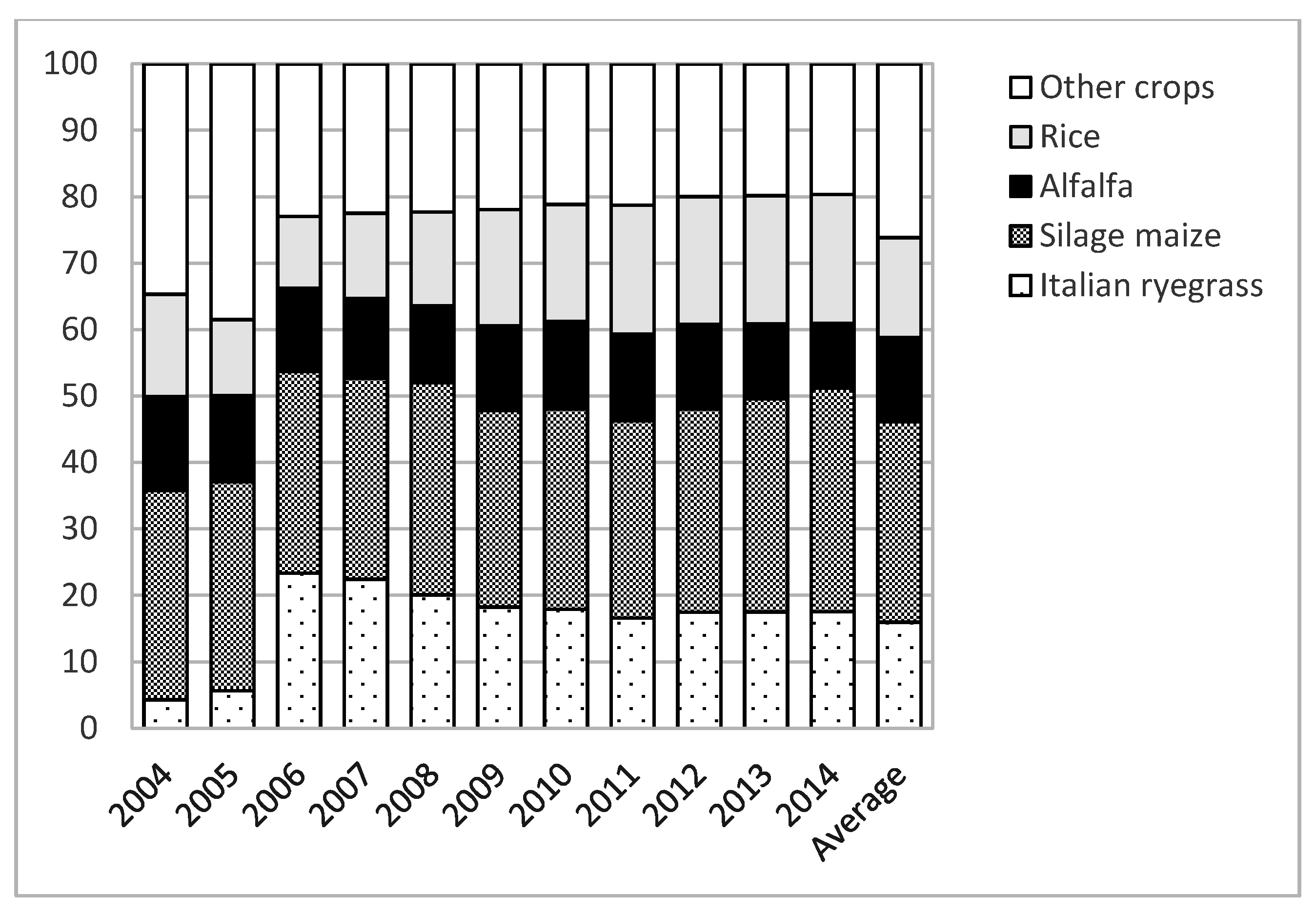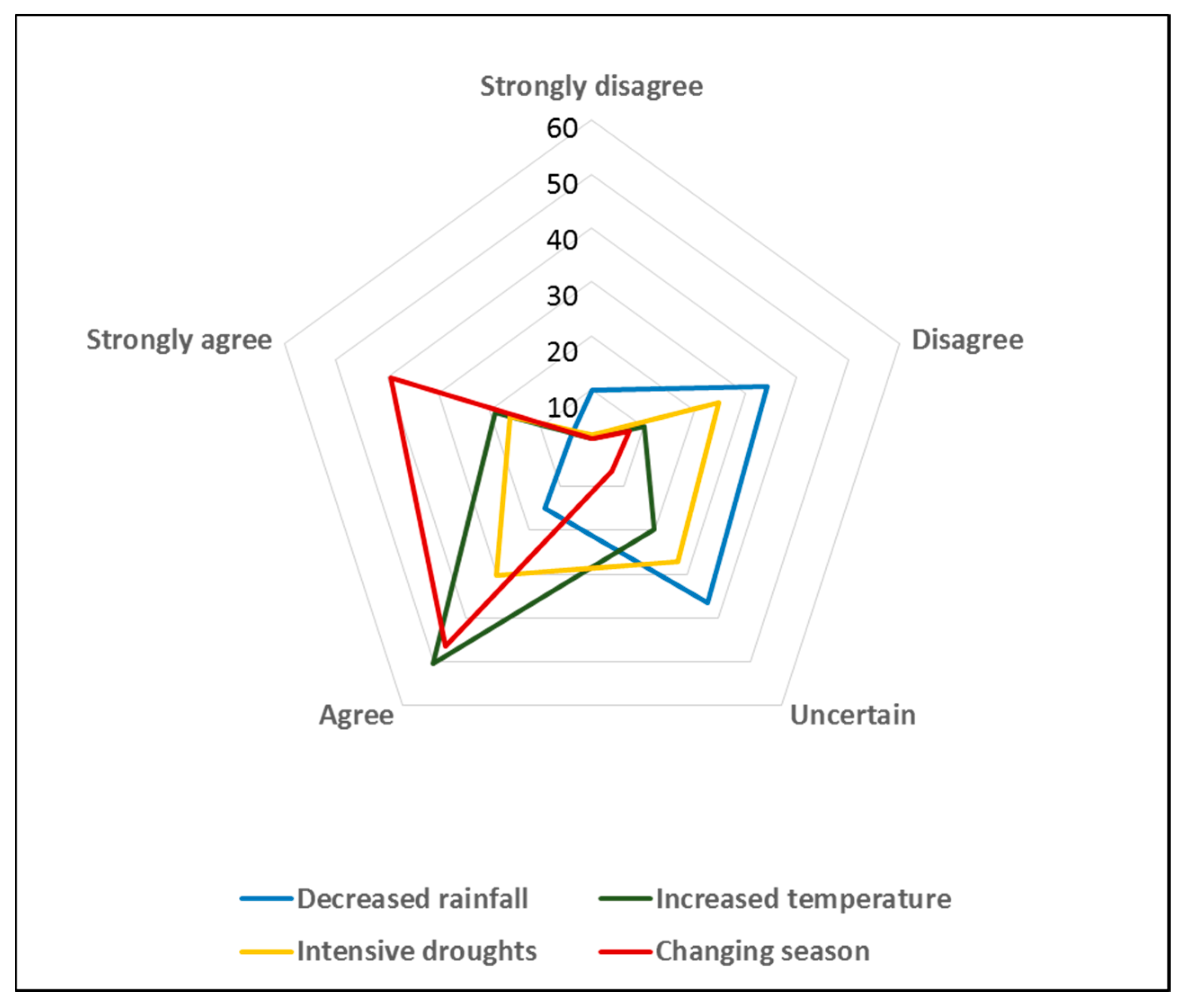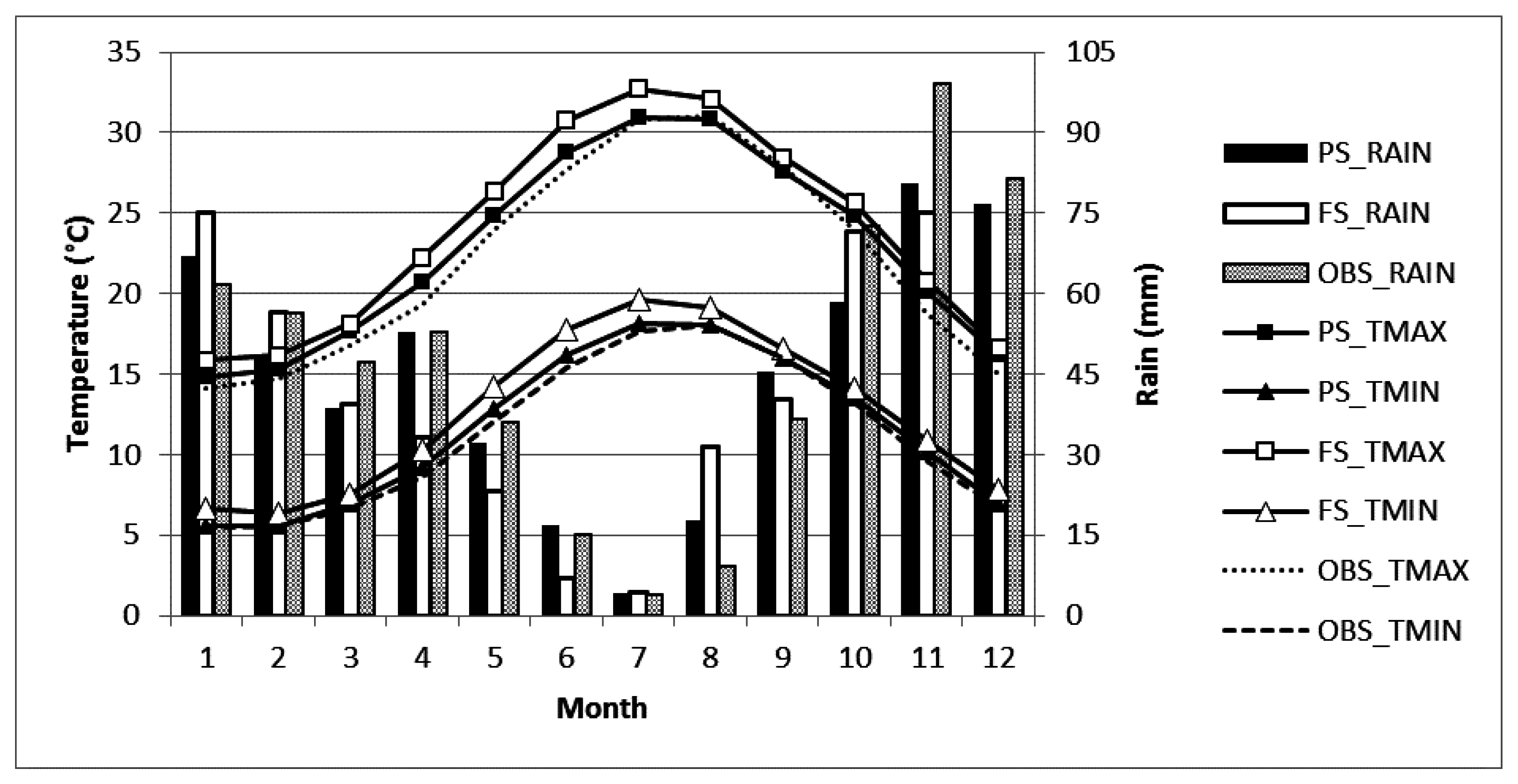Perceptions of Present and Future Climate Change Impacts on Water Availability for Agricultural Systems in the Western Mediterranean Region
Abstract
:1. Introduction
2. Conceptual Background
3. The Local Context
4. Research Methods
5. Results
5.1. Farmers’ Perceptions of Climate Variability
5.2. Farmers’ Perceptions of Climate Impacts
5.3. Farmers’ Beliefs about Climate Change and Water Availability
5.4. Present and Future Climatic Scenarios
5.5. Present and Future Scenarios of Crop Irrigation Needs
5.6. Baseline and Future Scenarios of Economic Impacts and Land-Use Changes for Various Farming Systems
6. Discussion
6.1. Symmetries and Asymmetries between Farmers’ Perceptions and Present and Future Climate Scenarios
6.2. Factors Influencing Farmers’ Beliefs and Concerns about Water Availability
7. Conclusions and Implications
Acknowledgments
Author Contributions
Conflicts of Interest
Appendix A. The DSP Model Specification
References
- Milano, M.; Ruelland, D.; Fernandez, S.; Dezetter, A.; Fabre, J.; Servat, E.; Fritsch, J.-M.; Ardoin-Bardin, S.; Thivet, G. Current state of Mediterranean water resources and future trends under climatic and anthropogenic changes. Hydrol. Sci. J. 2013, 58, 498–518. [Google Scholar] [CrossRef]
- Xoplaki, E.; González-Rouco, J.F.; Luterbacher, J.; Wanner, H. Wet season Mediterranean precipitation variability: Influence of large-scale dynamics and trends. Clim. Dyn. 2004, 23, 63–78. [Google Scholar] [CrossRef]
- Xoplaki, E.; Luterbacher, J.; González-Rouco, J.F. Mediterranean summer temperature and winter precipitation, large-scale dynamics, trends. IL Nuovo Cimento C 2006, 29, 45–54. [Google Scholar]
- Giorgi, F. Variability and trends of sub-continental scale surface climate in the twentieth century. Part II: AOGCM simulations. Clim. Dyn. 2002, 18, 693–708. [Google Scholar]
- Chbouki, N.; Stockton, C.W.; Myers, D.E. Spatio-temporal patterns of drought in Morocco. Int. J. Climatol. 1995, 15, 187–205. [Google Scholar] [CrossRef]
- Brunetti, M.; Maugeri, M.; Nanni, T. Variations of Temperature and Precipitation in Italy from 1866 to 1995. Theor. Appl. Climatol. 2000, 65, 165–174. [Google Scholar] [CrossRef]
- Intergovernmental Panel on Climate Change. Climate Change 2007—Fourth Assessment Report. Working Group II Report “Impacts, Adaptation and Vulnerability”; Cambridge University Press: Cambridge, UK, 2007. [Google Scholar]
- Alexandridis, T.; Cherif, I.; Chemin, Y.; Silleos, G.; Stavrinos, E.; Zalidis, G. Integrated Methodology for Estimating Water Use in Mediterranean Agricultural Areas. Remote Sens. 2009, 1, 445–465. [Google Scholar] [CrossRef]
- Rosenzweig, C.; Iglesias, A.; Yang, X.B.; Epstein, P.R.; Chivian, E. Climate Change and Extreme Weather Events; Implications for Food Production, Plant Diseases, and Pests. Glob. Chang. Hum. Health 2001, 2, 90–104. [Google Scholar] [CrossRef]
- Ziervogel, G.; New, M.; Archer van Garderen, E.; Midgley, G.; Taylor, A.; Hamann, R.; Stuart-Hill, S.; Myers, J.; Warburton, M. Climate change impacts and adaptation in South Africa. Wiley Interdiscip. Rev. Clim. Chang. 2014, 5, 605–620. [Google Scholar] [CrossRef]
- Reidsma, P.; Ewert, F.; Lansink, A.O.; Leemans, R. Adaptation to climate change and climate variability in European agriculture: The importance of farm level responses. Eur. J. Agron. 2010, 32, 91–102. [Google Scholar] [CrossRef]
- Rosenzweig, C.; Tubiello, F.N. Impacts of Global Climate Change on Mediterranean Agrigulture: Current Methodologies and Future Directions. An Introductory Essay. Mitig. Adapt. Strateg. Glob. Chang. 1997, 1, 219–232. [Google Scholar] [CrossRef]
- Smit, B.; Skinner, M. Adaptation options in agriculture to climate change: A typology. Mitig. Adapt. Strateg. Glob. Chang. 2002, 7, 85–114. [Google Scholar] [CrossRef]
- Howden, S.M.; Soussana, J.-F.; Tubiello, F.N.; Chhetri, N.; Dunlop, M.; Meinke, H. Adapting agriculture to climate change. Proc. Natl. Acad. Sci. USA 2007, 104, 19691–19696. [Google Scholar] [CrossRef] [PubMed]
- Nguyen, T.P.L.; Seddaiu, G.; Virdis, S.G.P.; Tidore, C.; Pasqui, M.; Roggero, P.P. Perceiving to learn or learning to perceive? Understanding farmers’ perceptions and adaptation to climate uncertainties. Agric. Syst. 2016, 143, 205–216. [Google Scholar] [CrossRef]
- Esham, M.; Garforth, C. Agricultural adaptation to climate change: Insights from a farming community in Sri Lanka. Mitig. Adapt. Strateg. Glob. Chang. 2013, 18, 535–549. [Google Scholar] [CrossRef]
- Mertz, O.; Mbow, C.; Reenberg, A.; Diouf, A. Farmers’ Perceptions of Climate Change and Agricultural Adaptation Strategies in Rural Sahel. Environ. Manag. 2009, 43, 804–816. [Google Scholar] [CrossRef] [PubMed]
- Allan, C.; Nguyen, T.P.L.; Seddaiu, G.; Wilson, B.; Roggero, P.P. Integrating local knowledge with experimental research: Case studies on managing cropping systems in Italy and Australia. Ital. J. Agron. 2013, 8, e15. [Google Scholar] [CrossRef]
- Ostrom, E. Polycentric systems for coping with collective action and global environmental change. Glob. Environ. Chang. 2010, 20, 550–557. [Google Scholar] [CrossRef]
- Burton, I.A.N.; Bizikova, L.; Dickinson, T.; Howard, Y. Integrating adaptation into policy: Upscaling evidence from local to global. Clim. Policy 2007, 7, 371–376. [Google Scholar] [CrossRef]
- Ogalleh, S.; Vogl, C.; Eitzinger, J.; Hauser, M. Local Perceptions and Responses to Climate Change and Variability: The Case of Laikipia District, Kenya. Sustainability 2012, 4, 3302–3325. [Google Scholar] [CrossRef]
- Hartter, J.; Stampone, M.D.; Ryan, S.J.; Kirner, K.; Chapman, C.A.; Goldman, A. Patterns and Perceptions of Climate Change in a Biodiversity Conservation Hotspot. PLoS ONE 2012, 7, e32408. [Google Scholar] [CrossRef] [PubMed]
- Osbahr, H.; Dorward, P.; Stern, R.; Cooper, S. Supporting agricultural innovation in uganda to respond to climate risk: Linking climate change and variability with farmer perceptions. Exp. Agric. 2011, 47, 293–316. [Google Scholar] [CrossRef]
- Gandure, S.; Walker, S.; Botha, J.J. Farmers’ perceptions of adaptation to climate change and water stress in a South African rural community. Environ. Dev. 2013, 5, 39–53. [Google Scholar] [CrossRef]
- Deressa, T.T.; Hassan, R.M.; Ringler, C.; Alemu, T.; Yesuf, M. Determinants of farmers’ choice of adaptation methods to climate change in the Nile Basin of Ethiopia. Glob. Environ. Chang. 2009, 19, 248–255. [Google Scholar] [CrossRef]
- Roncoli, C.; Ingram, K.; Kirshen, P. Reading the Rains: Local Knowledge and Rainfall Forecasting in Burkina Faso. Soc. Nat. Resour. 2002, 15, 409–427. [Google Scholar] [CrossRef]
- Michaels, C.F. Information, Perception, and Action: What Should Ecological Psychologists Learn from Milner and Goodale (1995)? Ecol. Psychol. 2000, 12, 241–258. [Google Scholar] [CrossRef]
- Gilg, A.; Barr, S. Behavioural attitudes towards water saving? Evidence from a study of environmental actions. Ecol. Econ. 2006, 57, 400–414. [Google Scholar] [CrossRef]
- Dessai, S.; Sims, C. Public perception of drought and climate change in southeast England. Environ. Hazards 2010, 9, 340–357. [Google Scholar] [CrossRef]
- Bauer, M.; Botti, P.; Zaccolo, S.; Olsson, O. Enhanced reservoir operation as an instrument for supporting water stress mitigation: The Italian case study 196. In The Use of Economic Valuation in Environmental Policy: Providing Research Support for the Implementation of EU Water Policy Under Aquastress; Koundouri, P., Ed.; Routledge: London, UK; New York, NY, USA, 2011; p. 244. [Google Scholar]
- Sannitu, S. The integrated water cycle in the context of water management systems: The sardinian experience. In Water Resources for the Future, Proceedings of the International Conference Organized in Collaboration with the Italian Ministry for the Environment and Territory, Porto Cervo, Sassari, Sardinia, Italy, 22–24 October 2003; Tennyson, L., Zingari, P.C., Eds.; FAO: Rome, Italy, 2006; pp. 152–182. [Google Scholar]
- Manca, A. L’applicazione Della Direttiva Nitrati: Ricadute e Problematiche Nella Zootecnia; Agenzia Regionale per lo Sviluppo in Agricoltua: Cagliari, Italy, 2009. [Google Scholar]
- Nguyen, T.P.L.; Seddaiu, G.; Roggero, P.P. Hybrid knowledge for understanding complex agri-environmental issues: Nitrate pollution in Italy. Int. J. Agric. Sustain. 2014, 12, 1–19. [Google Scholar] [CrossRef]
- Demurtas, C.E.; Seddaiu, G.; Ledda, L.; Cappai, C.; Doro, L.; Carletti, A.; Roggero, P.P. Replacing organic with mineral N fertilization does not reduce nitrate leaching in double crop forage systems under Mediterranean conditions. Agric. Ecosyst. Environ. 2016, 219, 83–92. [Google Scholar] [CrossRef]
- Aschmann, H. Distribution and Peculiarity of Mediterranean Ecosystems. In Mediterranean Type Ecosystems; Castri, F., Mooney, H., Eds.; Springer: Berlin/Heidelberg, Germany, 1973; Volume 7, pp. 11–19. [Google Scholar]
- Regione Autonoma della Sardegna (RAS). Il 6° Censimento Generale Dell Agricoltura in Sardegna. Caratteristiche Delle Aziende Agricole Regionali; RAS: Cagliari, Italy, 2013; p. 110. [Google Scholar]
- Meneguzzo, F.; Pasqui, M.; Menduni, G.; Messeri, G.; Gozzini, B.; Grifoni, D.; Rossi, M.; Maracchi, G. Sensitivity of meteorological high-resolution numerical simulations of the biggest floods occurred over the Arno river basin, Italy, in the 20th century. J. Hydrol. 2004, 288, 37–56. [Google Scholar] [CrossRef]
- Hayhoe, H.N. Relationship between weather variables in observed and WXGEN generated data series. Agric. For. Meteorol. 1998, 90, 203–214. [Google Scholar] [CrossRef]
- Williams, J.R. The EPIC model, 1995. In Computer Models of Watershed Hydrology; Singh, V.P., Ed.; Water Resources Publications: Highlands Ranch, CO, USA, 1995; pp. 909–1000. [Google Scholar]
- Jones, J.W.; Hoogenboom, G.; Porter, C.H.; Boote, K.J.; Batchelor, W.D.; Hunt, L.A.; Wilkens, P.W.; Singh, U.; Gijsman, A.J.; Ritchie, J.T. The DSSAT cropping system model. Eur. J. Agron. 2003, 18, 235–265. [Google Scholar] [CrossRef]
- Hoogenboom, G.; Jones, J.W.; Wilkens, P.W.; Porter, C.H.; Boote, K.J.; Hunt, L.A.; Singh, U.; Lizaso, J.L.; White, J.W.; Uryasev, O.; et al. Decision Support System for Agrotechnology Transfer (DSSAT); Version 4.5; University of Hawaii: Honolulu, HI, USA, 2012. [Google Scholar]
- Balkovič, J.; van der Velde, M.; Schmid, E.; Skalský, R.; Khabarov, N.; Obersteiner, M.; Stürmer, B.; Xiong, W. Pan-European crop modelling with EPIC: Implementation, up-scaling and regional crop yield validation. Agric. Syst. 2013, 120, 61–75. [Google Scholar] [CrossRef]
- Wang, X.; He, X.; Williams, J.R.; Izaurralde, R.C.; Atwood, J.D. Sensitivity and uncertainty analyses of crop yields and soil organic carbon simulated with EPIC. Trans. ASAE 2005, 48, 1041–1054. [Google Scholar] [CrossRef]
- Easterling, W.E.; Mearns, L.O.; Hays, C.J.; Marx, D. Comparison of Agricultural Impacts of Climate Change Calculated from High and Low Resolution Climate Change Scenarios: Part II. Accounting for Adaptation and CO2 Direct Effects. Clim. Chang. 2001, 51, 173–197. [Google Scholar] [CrossRef]
- Liu, J.; Williams, J.R.; Zehnder, A.J.B.; Yang, H. GEPIC—Modelling wheat yield and crop water productivity with high resolution on a global scale. Agric. Syst. 2007, 94, 478–493. [Google Scholar] [CrossRef]
- Hunt, L.A.; Pararajasingham, S.; Jones, J.W.; Hoogenboom, G.; Imamura, D.T.; Ogoshi, R.M. GENCALC: Software to Facilitate the Use of Crop Models for Analyzing Field Experiments. Agron. J. 1993, 85, 1090–1094. [Google Scholar] [CrossRef]
- Dono, G.; Cortignani, R.; Dell’Unto, D.; Deligios, P.; Doro, L.; Lacetera, N.; Mula, L.; Pasqui, M.; Quaresima, S.; Vitali, A.; et al. Winners and losers from climate change in agriculture: Insights from a case study in the Mediterranean basin. Agric. Syst. 2016, 147, 65–75. [Google Scholar] [CrossRef]
- Gibson, J. The Ecological Approach to Visual Perception; Lawrence Erlbaum Associates: Oxfordshire, UK, 1986. [Google Scholar]
- Marx, S.M.; Weber, E.U.; Orlove, B.S.; Leiserowitz, A.; Krantz, D.H.; Roncoli, C.; Phillips, J. Communication and mental processes: Experiential and analytic processing of uncertain climate information. Glob. Environ. Chang. 2007, 17, 47–58. [Google Scholar] [CrossRef]
- Pradhan, N.S.; Sijapati, S.; Bajracharya, S.R. Farmers’ responses to climate change impact on water availability: Insights from the Indrawati Basin in Nepal. Int. J. Water Resour. Dev. 2015, 31, 269–283. [Google Scholar] [CrossRef]
- Desalegn, C.E.; Babel, M.S.; Gupta, A.D.; Seleshi, B.A.; Merrey, D. Farmers’perception of water management under drought conditions in the upper awash basin, Ethiopia. Int. J. Water Resour. Dev. 2006, 22, 589–602. [Google Scholar] [CrossRef]
- Ferrier, N.; Haque, C.E. Hazards risk assessment methodology for emergency managers: A standardized framework for application. Nat. Hazards 2003, 28, 271–290. [Google Scholar] [CrossRef]
- Saarinen, T.F. Perception of the Drought Hazard on the Great Plains; Depatment of Geography, University of Chicago: Chicago, IL, USA, 1966. [Google Scholar]
- Bryant, C.; Smit, B.; Brklacich, M.; Johnston, T.; Smithers, J.; Chjotti, Q.; Singh, B. Adaptation in Canadian Agriculture to Climatic Variability and Change. Clim. Chang. 2000, 45, 181–201. [Google Scholar] [CrossRef]
- Christensen, J.; Kowalski, M. Using Water Wisely. Quantitative Research to Determine Consumers’ Attitudes to Water Use and Water Conservation. Report for Consumer Council for Water in Association with WRc; MVa Consultancy; Consumer Council for Water: London, UK, 2006. [Google Scholar]
- Howe, P.D.; Leiserowitz, A. Who remembers a hot summer or a cold winter? The asymmetric effect of beliefs about global warming on perceptions of local climate conditions in the U.S. Glob. Environ. Chang. 2013, 23, 1488–1500. [Google Scholar] [CrossRef]
- Lorenzoni, I.; Nicholson-Cole, S.; Whitmarsh, L. Barriers perceived to engaging with climate change among the UK public and their policy implications. Glob. Environ. Chang. 2007, 17, 445–459. [Google Scholar] [CrossRef]
- Spaargaren, G.; Van Vliet, B. Lifestyles, consumption and the environment: The ecological modernization of domestic consumption. Environ. Politics 2000, 9, 50–76. [Google Scholar]
- Barr, S.; Gilg, A.W. Conceptualising and analysing household attitudes and actions to a growing environmental problem: Development and application of a framework to guide local waste policy. Appl. Geogr. 2005, 25, 226–247. [Google Scholar] [CrossRef]
- Hoanh, C.; Johnston, R.; Smakhtin, V. Climate Change and Agriculture Development: A Challenge for water management. In Climate Change and Agricultural Water Management in Developing Countries; Hoanh, C., Smakhtin, V., Johnston, R., Eds.; CABI: Wallingford, UK, 2015. [Google Scholar]
- Petrosillo, I.; Valente, D.; Zaccarelli, N.; Zurlini, G. Managing tourist harbors: Are managers aware of the real environmental risks? Mar. Pollut. Bull. 2009, 58, 1454–1461. [Google Scholar] [CrossRef] [PubMed]
- Cortignani, R.; Dono, G. Simulation of the impact of greening measures in an agricultural area of the southern Italy. Land Use Policy 2015, 48, 525–533. [Google Scholar] [CrossRef]





| Crop System | Land Use | Irrigation Needs | Percentage Changes Future Climate vs. Present |
|---|---|---|---|
| (%) | (mm) | (%Δ) | |
| Italian ryegrass | 16 | 114 | +40 |
| Silage maize | 30 | 429 | −4 |
| Alfalfa | 13 | 516–639 | +5 |
| Rice | 15 | 664 | −1 |
| Present (000 €) | Near Future (% Changes over Present) | |||||||
|---|---|---|---|---|---|---|---|---|
| Rice | Cattle A | Cattle B | Total Area | Rice | Cattle A | Cattle B | Total Area | |
| Total revenue | 9,511 | 59,194 | 16,492 | 85,197 | 4.1 | −1.3 | −0.9 | −0.6 |
| Crops | 9,511 | 252 | 156 | 9,919 | 4.1 | 11.5 | 57.6 | 5.1 |
| Animals | 0 | 58,942 | 16,336 | 75,278 | 0.0 | −1.3 | −1.4 | −1.3 |
| Variable costs | 7,013 | 33,119 | 9,124 | 49,257 | −0.2 | 1.8 | 2.9 | 1.7 |
| Feeds | 0 | 15,689 | 3,319 | 19,008 | - | −5.2 | −6.4 | −5.4 |
| Gross margin | 5,294 | 35,509 | 9,941 | 50,744 | 7.6 | −3.8 | −4.1 | −2.6 |
| Net income | 4,317 | 26,355 | 6,825 | 37,498 | 9.3 | −5.1 | −5.9 | −3.6 |
| Present (Hectares) | Near Future (% Changes over Present) | |||||||
|---|---|---|---|---|---|---|---|---|
| Rice | Cattle A | Cattle B | Total Area | Rice | Cattle A | Cattle B | Total Area | |
| alfalfa | 25 | 528 | 276 | 829 | −15.4 | −77.6 | −53.4 | −67.7 |
| corn silage total | 0 | 3215 | 1050 | 4265 | - | 12.9 | 12.4 | 12.8 |
| standard hybrid | 0 | 3215 | 1050 | 4265 | - | −22.2 | −21.9 | −22.1 |
| hybrid with shorter cycle | 0 | 0 | 0 | 0 | - | 1129 | 360 | 1489 |
| ryegrass | 0 | 2198 | 720 | 2917 | - | 9.2 | 12.4 | 10.0 |
| rice | 2422 | 0 | 0 | 2422 | 0.3 | - | - | 0.3 |
| other crops | 653 | 413 | 84 | 1150 | −0.6 | 1.7 | 51.2 | 4.0 |
© 2016 by the authors; licensee MDPI, Basel, Switzerland. This article is an open access article distributed under the terms and conditions of the Creative Commons Attribution (CC-BY) license (http://creativecommons.org/licenses/by/4.0/).
Share and Cite
Nguyen, T.P.L.; Mula, L.; Cortignani, R.; Seddaiu, G.; Dono, G.; Virdis, S.G.P.; Pasqui, M.; Roggero, P.P. Perceptions of Present and Future Climate Change Impacts on Water Availability for Agricultural Systems in the Western Mediterranean Region. Water 2016, 8, 523. https://doi.org/10.3390/w8110523
Nguyen TPL, Mula L, Cortignani R, Seddaiu G, Dono G, Virdis SGP, Pasqui M, Roggero PP. Perceptions of Present and Future Climate Change Impacts on Water Availability for Agricultural Systems in the Western Mediterranean Region. Water. 2016; 8(11):523. https://doi.org/10.3390/w8110523
Chicago/Turabian StyleNguyen, Thi Phuoc Lai, Laura Mula, Raffaele Cortignani, Giovanna Seddaiu, Gabriele Dono, Salvatore G.P. Virdis, Massimiliano Pasqui, and Pier Paolo Roggero. 2016. "Perceptions of Present and Future Climate Change Impacts on Water Availability for Agricultural Systems in the Western Mediterranean Region" Water 8, no. 11: 523. https://doi.org/10.3390/w8110523






